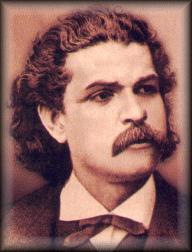Antonio Carlos Gomes
|
|
Antônio Carlos Gomes (July 11, 1836 - September 16, 1896) is one of the most distinguished nineteenth century classical composers, being the first New World composer whose work was accepted by Europe.
He was born in the village of São Carlos, which is now the city of Campinas, Brazil, son of Maestro Manuel José Gomes and Fabiana Maria Jaguari Cardoso.
His childhood's musical tendencies were soon stimulated by his father and by his older brother José Pedro de Sant'Ana Gomes, also a Conductor. José Pedro was the most dedicated guide and adviser in his brother's artistic career. He convinced Antônio to visit the Court where he became a protegé of the Emperor Dom Pedro II, who, being notoriously interested in the careers of Brazilian artists and intellectuals, made possible for Antônio Carlos to study at the Musical Conservatory of Rio de Janeiro.
After having graduated with honors, Carlos produced his first opera, A Noite Do Castelo (September 1861). It was a big success. Two years later, he repeated it with his second opera, Joana De Flandres, which was considered superior to the first. These two pieces convinced the Emperor to offer him a Royal scholarship to study in Italy in 1864. He studied in Milan at the local Conservatory and completed in three years a course which was normally completed in four years, obtaining the title of Maestro Composer.
Interested in composing an opera which dealt with a truly Brazilian subject, Carlos Gomes choose as the theme of his next work the romance novel O Guarani, by Brazilian writer José Alencar. The opera was given an Indian subject and setting and it premiered in May of 1870 at the La Scala Theater in Milan as Il Guarany.
The success was enormous. Even the most strict musical critics compared the Brazilian musician to the great European maestros, such as Rossini and Verdi. The King of Italy, Victor Emmanuel II, decorated the creator of the opera, which was presented in all major European capitals. Before that year was over, Gomes returned to Brazil where he organized the premiere of Il Guarany in Rio de Janeiro. The piece achieved the same success Gomes had seen in Italy.
Returning to Italy, Carlos Gomes married Adelina Peri, an Italian pianist he had met while studying in Milan. He wrote the hymn Il saluto del Brasile for the centenary of American independence which was performed in Philadelphia, on July 19, 1876.
In 1883 the maestro travelled to Brazil, receiving homages in every city he visited. When he returned to Italy, he dedicated himself to the composition of an opera themed against slavery, inspired by the liberation struggle of black slaves in Brazil, which got the title of Lo Schiavo. The composition, which had been suggested by a great friend of Antônio's, a black engineer named André Rebouças, only debuted several years later in 1889.
When the Brazilian republic was proclaimed, Carlos Gomes, who at this time was in Campinas, sailed once more to Italy. Faithful to the monarchy and Dom Pedro II, Gomes refused the opportunity given to him by president Mal. Deodoro da Fonseca to compose the Brazilian National Anthem. In the following years, he composed the opera Condor and the cantata Colombo, for the Columbus Festival (October 12, 1892), in celebration of the forth centenary of the discovery of America.
Invited by the governor of Pará to direct the Musical Conservatory of that state, the maestro travelled to the capital Belém, willing to take the position. However, shortly after arriving, Carlos Gomes, by then an elderly man in poor health, died on September 16, 1896. Besides his eight operas, he composed songs (3 books), choruses, and piano pieces.
Antônio Carlos Gomes's operas
- Noite do Castelo (1861)
- Joana de Flandres (1863)
- Il Guarany (1870)
- Fosca (1873)
- Salvator Rosa (1874)
- Maria Tudor (1879)
- Lo Schiavo (1889)
- Condor (1891)
External references
- Baker's Biographical Dictionary of Musicians, 8th ed., s.v. "Antonio Carlos Gomes."
- Brazilian National Library Virtual Archives (http://www.bn.br/fbn/musica/eacervo.htm)pt:Antônio Carlos Gomes

